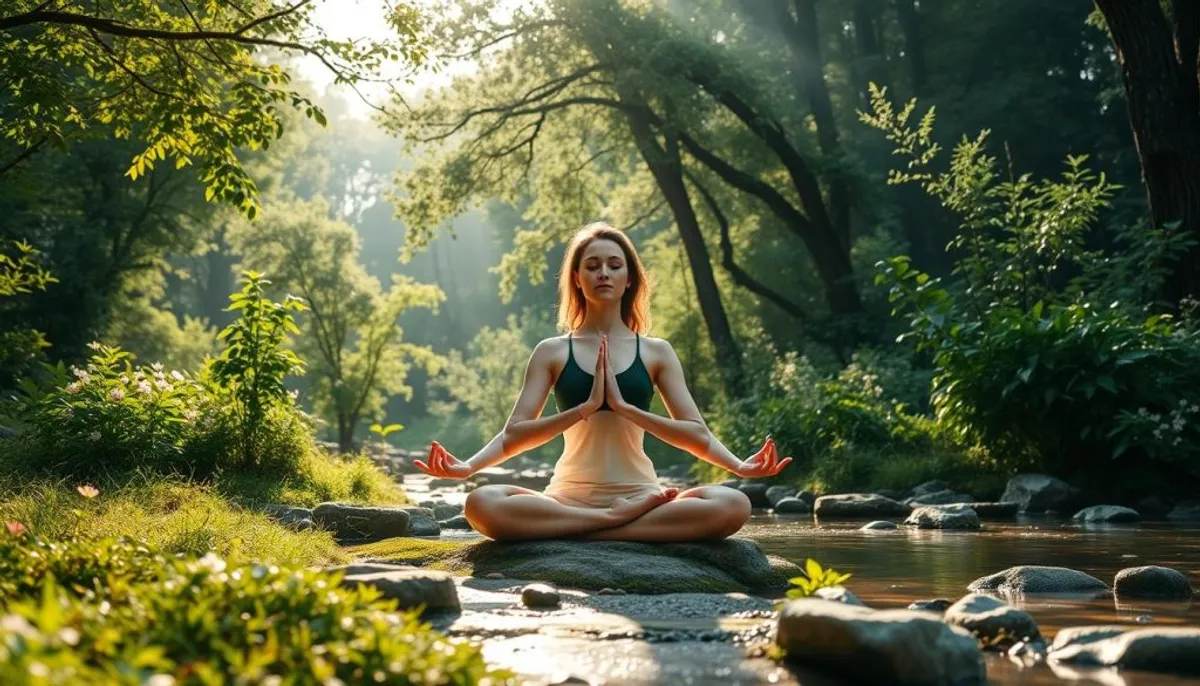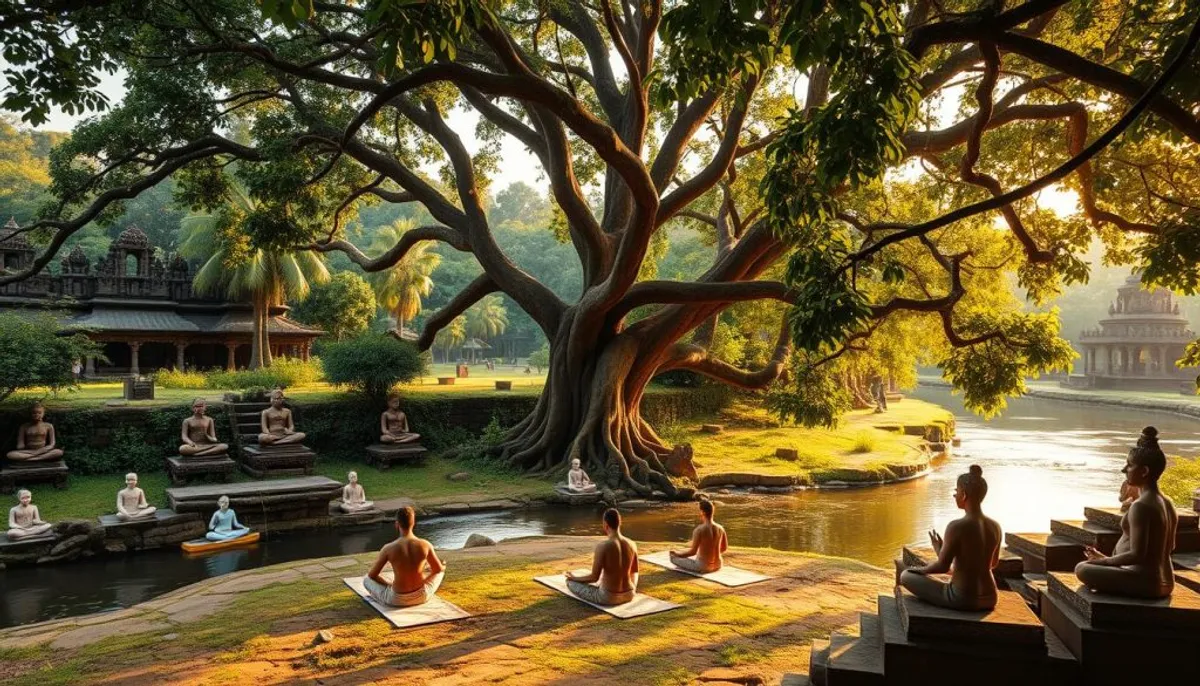Yoga, an ancient practice, finds its roots in the Indus-Sarasvati civilization, dating back over 5,000 years. This discipline, which means “union” in Sanskrit, aims to unite the body, mind, and soul. It promises deep harmony, essential for well-being.
In France, the popularity of yoga is growing significantly. Brands like Yogom, led by Mathilde Corbin, offer a variety of eco-friendly accessories. These tools are designed to support practitioners in their quest for serenity. This holistic approach is attracting more and more people wishing to balance their daily lives.

The benefits of yoga are well documented and scientifically validated. A study by the American Psychological Association shows that 72% of practitioners notice a significant reduction in stress. Yoga also improves flexibility, strengthens muscles, and corrects posture. These effects contribute to overall well-being.
The ancient origins of yoga: from ancient India to the present day
The history of yoga is deeply rooted in Indian civilization. This ancestral practice dates back over 5,000 years, finding its origins in the Indus-Sarasvati valley. Figurines dating back to around 5500 BC illustrating yoga postures testify to its antiquity.
The Vedic roots and the Indus-Sarasvati civilization
The period of high historical antiquity, between 3000 and 800 BC, marks the beginnings of yoga. Sacred texts like the Rig Veda mention the term “yoga” for the first time. This era saw the birth of the philosophical and spiritual foundations of this ancient practice.
The evolution of sacred texts: from the Vedas to the Upanishads
The evolution of yoga is reflected in its holy texts. The Upanishads, composed of over 200 writings, deepened yogic concepts. The Bhagavad-Gita, written around 500 BC, is considered one of the most influential texts. The yoga sutras of Patanjali, comprising 195 short inspiring texts, shaped later currents of yoga.

The deep meaning of the word “yoga”
The word “yoga” originates from the Sanskrit “yuj,” meaning “to unite” or “to join.” This definition reflects the very essence of the practice: the union of the body, mind, and soul. Over the centuries, yoga has traversed various periods and influenced many cultures, gradually spreading to the West in the 20th century.
| Period | Dates | Key Events |
|---|---|---|
| High Antiquity | 3000 to 800 BC | First mentions of yoga in the Vedas |
| Proto-yoga | 800 BC to 200 AD | Development of yogic concepts |
| Classical | 300 to 900 AD | Writing of Patanjali's yoga sutras |
| Medieval | 900 to 1600 AD | Influence on Shaivite and Vaishnavite currents |
| Modern | 20th century | Spread to the West, over 250 million practitioners worldwide |
Yoga culture: a holistic approach to well-being
Yoga represents a comprehensive vision of well-being, merging body, mind, and soul. This philosophy, rooted in history, offers a complete method to achieve inner and outer balance. The regular practice of yoga transforms our existence, leading us toward an optimal state of balance.
The union of body, mind, and soul
Yoga aims to unify the different facets of our being. Asanas strengthen and stretch the body, while pranayama optimizes our breathing. Meditation calms thoughts and enhances our mental clarity. This synergy creates a sense of harmony and fullness.

The eight fundamental principles of practice
The principles of yoga, detailed in the Yoga Sutras of Patanjali, guide the practitioner toward self-realization. These eight principles include the richness of Zanzibar culture:
- Yama and Niyama: ethical principles
- Asana: physical postures
- Pranayama: breath control
- Pratyahara: withdrawal of the senses
- Dharana: concentration
- Dhyana: meditation
- Samadhi: higher state of consciousness
- adult dance classes
The yogic philosophy in daily life
Integrating yogic philosophy into our daily lives transforms our relationship with the world. Choosing a sattvic diet, rich in pure foods, is essential. Using mantras like “Om” enhances our concentration. Yoga retreats offer a deep immersion in practice. Keeping a journal allows us to track our personal growth. Thus, yoga becomes a true art of living, enriching every aspect of our existence.
The transformative benefits of yoga practice
Yoga is a practice rich in benefits for health, both physical and mental. After seven years of practice and study, I obtained a RYT 200 diploma from The Yoga Mat school in Canada. This experience has been transformative, allowing me to experience the positive effects of yoga on personal transformation.
Physically, yoga increases flexibility and strengthens the skeleton and joints. It also alleviates back problems. The regular practice contributes to developing strength and balance. Mentally, it clarifies the mind, improves concentration, and stimulates memory.
The emotional benefits of yoga are also significant. It helps better manage stress and reduces anxiety. Moreover, it improves sleep quality. By focusing on the present moment, one develops better self-awareness and learns to release tensions.
| Aspect | Benefits of yoga |
|---|---|
| Physical | Increased flexibility, strengthened skeleton, relief from back pain |
| Mental | Clarity of mind, better concentration, improved memory |
| Emotional | Stress management, reduced anxiety, better sleep |
The practice of yoga leads to a sense of overall well-being. It fosters a deep personal transformation. It allows one to find inner freedom and a better self-knowledge. With over two million practitioners in France, yoga is establishing itself as an effective path toward better health and personal fulfillment.
The art of breathing and body awareness
Deep breathing is at the heart of yoga, playing an essential role in the development of body awareness. It allows for full presence. The techniques of pranayama, the yogic art of breathing, bring numerous benefits for the body and mind.
Deep breathing as a central pillar
Pranayama reduces stress and improves emotional management. It clarifies the mind. By focusing on the breath, one calms the nervous system and improves blood circulation. The exercises recommend a rhythm of 3 to 4 cycles per minute, promoting deep calm.
The importance of full presence
The practice of yoga fosters hyper-awareness of the body. By concentrating on every detail of the postures, one develops a better connection with oneself. Silent meditation, often practiced with yoga, allows for a connection to deep inner tranquility, especially by practicing techniques like Cape Verde.
The release of physical and emotional tensions
The combination of yoga postures and meditation acts as emotional therapy. It releases physical, mental, and emotional tensions. Savasana, or the relaxation posture, is particularly effective in promoting self-awareness.
| Technique | Duration | Benefits |
|---|---|---|
| Ujjayi Pranayama | 5-10 minutes | Calming, mental clarity |
| Kapalabhati | 3-5 minutes | Nasal cleansing, abdominal strengthening |
| Nadi Sodhana | 5-7 minutes | Energetic balance, relaxation |
Conclusion
Yoga, with its ancient roots in Indian Vedic culture, transcends the simple practice of exercises. It is a holistic discipline, integrating the physical, mental, and spiritual dimensions of the individual. The benefits of yoga are varied, influencing both the strengthening of the body and the tranquility of the mind.
The regular practice of yoga contributes to improving strength, flexibility, and balance. It encourages the exploration of conscious breathing, or Pranayama, to manage our vital energy. This method enhances our body awareness and encourages healthier lifestyle habits.
The harmony between body and mind, the pivot of yogic philosophy, develops through meditation and mindfulness. It is essential to understand and respect the Indian origins of yoga, embracing its authentic cultural and spiritual aspects. Yoga proves to be a path to overall well-being, open to all, regardless of physical condition or personal situation.
RelatedRelated articles


